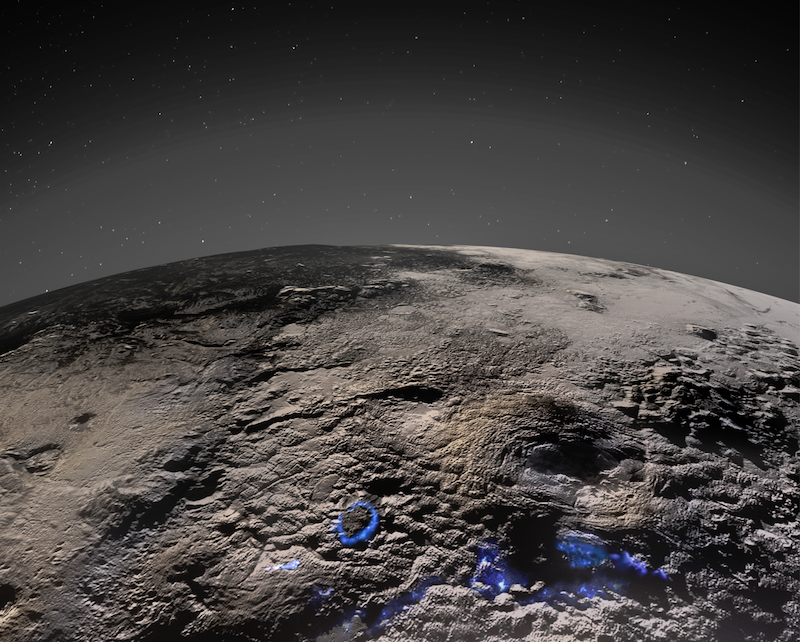
Nearly seven years after New Horizons visited Pluto, the little world is still revealing itself to be geologically complex. It has regions of terrain on its surface unlike anything else in the solar system. On March 29, 2022, scientists announced that giant ice volcanoes created some of Pluto’s most unusual surface features. Evidence suggests that this activity continued until quite recently, geologically speaking, and these ice volcanoes may even still be erupting today.
The researchers, part of the New Horizons mission, published their peer-reviewed findings in Nature Communications on March 29, 2022.
Pluto’s giant ice volcanoes
When New Horizons flew past Pluto on July 14, 2015, it discovered a world unlike any we’d seen before. It saw mountains made of solid water ice (with caps of methane snow) and vast smooth glacier-like plains of nitrogen ice. Also, at least one large mound that looked a lot like a volcano. Plus, there is even evidence that Pluto may still harbor a subsurface ocean of water!
Now, in the latest research, scientists say that cryovolcanoes, or ice volcanoes, created some of Pluto’s most enigmatic terrain. These volcanoes spew “lava” composed of ice and water instead of molten rock. Wright Mons, a large caldera-like feature, is the most well-known. It was the first tentative ice volcano identified by mission scientists soon after New Horizons’ flyby.

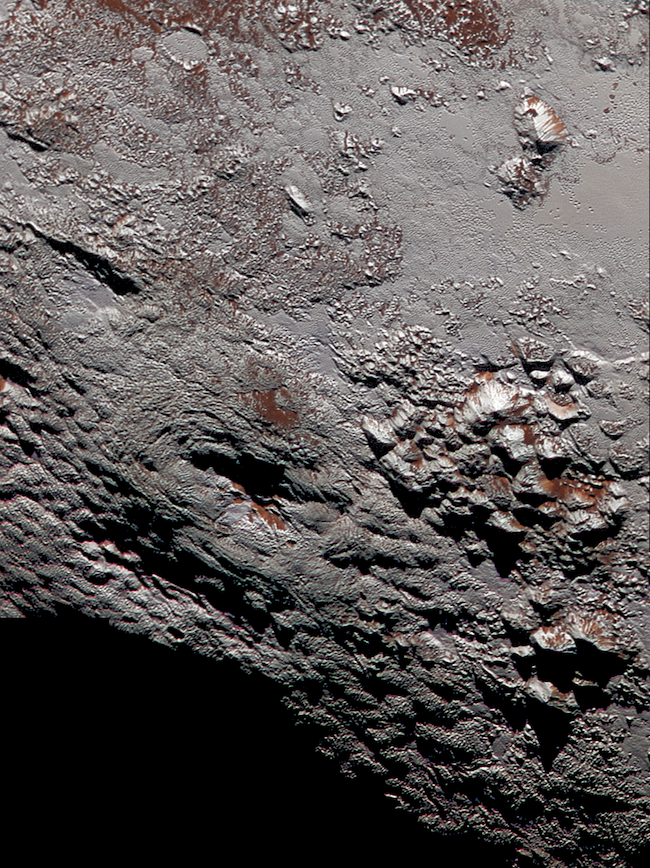
But how could there be this kind of geological activity on this small dwarf planet so far from the sun?
Scientists have been trying to answer this question ever since that first close-up look in 2015.
Multiple large domes near Pluto’s ‘heart’
While studying images and other data sent back by New Horizons, the researchers found multiple large domes that appeared to be ice volcanoes. Kelsi Singer, New Horizons deputy project scientist from the Southwest Research Institute (SwRI) and lead author of the new study, stated:
The particular structures we studied are unique to Pluto, at least so far. Rather than erosion or other geologic processes, cryovolcanic activity appears to have extruded large amounts of material onto Pluto’s exterior and resurfaced an entire region of the hemisphere New Horizons saw up close.
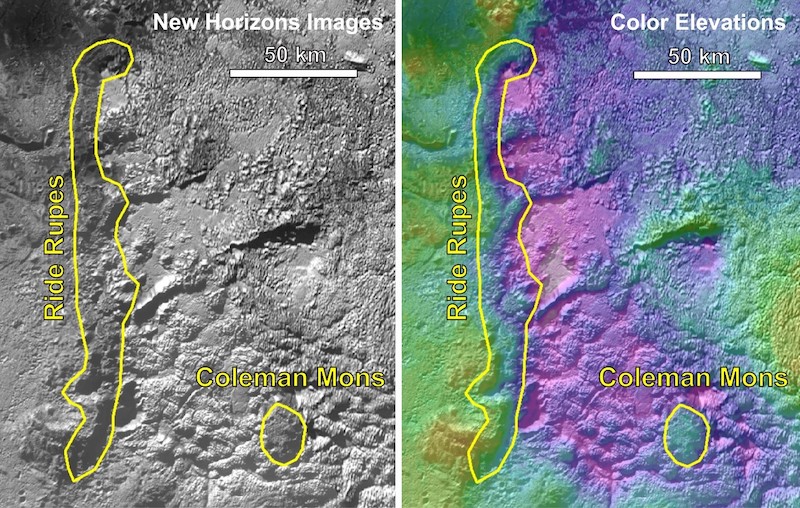
The domes are located in a region known as Pluto’s “heart,” southwest of Sputnik Planitia. These are the nitrogen ice plains that roughly form the shape of a heart. They range from about 1/2 to 4 miles (1 to 7 km) tall and 18 to 60 miles (30 to 100 km) across. Some of them have merged together to form larger structures. There is also hummocky terrain – irregular interconnected hills, mounds and depressions – on the sides of the larger domes. The largest domes are similar in size to Mauna Loa volcano in Hawaii.
Geologically young terrain
The researchers know that this terrain is geologically young because there are very few craters in this region. It is also unique in the solar system, as noted in the paper:
The New Horizons spacecraft returned images and compositional data showing that terrains on Pluto span a variety of ages, ranging from relatively ancient, heavily cratered areas to very young surfaces with few-to-no impact craters. One of the regions with very few impact craters is dominated by enormous rises with hummocky flanks. Similar features do not exist anywhere else in the imaged solar system.
How did the giant ice volcanoes form?
So, how did these icy domes form? The researchers ruled out ordinary erosion, due to significant variations in the highs and lows of the terrain. They also consider glacial erosion or sublimation erosion unlikely, because they’ve found no evidence for it in the hummocky terrain.
So what does that leave? According to the researchers, ice volcanoes are the likely explanation. Singer said:
One of the benefits of exploring new places in the solar system is that we find things we weren’t expecting. These giant, strange-looking cryovolcanoes observed by New Horizons are a great example of how we are expanding our knowledge of volcanic processes and geologic activity on icy worlds.

Interior heat needed for cryovolcanic flows
There is still a bit of a mystery, however. Pluto is so cold that even water containing ammonia or salts freezes quickly on its surface. So how did these water-ice flows occur? The researchers say that Pluto may have retained more interior heat than previously thought. This heat could have persisted at least until the recent geological past. Despite the freezing cold, the icy material could have still flowed across the surface if it had toothpaste-like consistency. Or, it may have behaved like ice glaciers on Earth. Another possibility is it had a frozen shell or cap with material that was able to flow underneath it. As outlined in the paper:
The existence of these massive features suggests Pluto’s interior structure and evolution allows for either enhanced retention of heat or more heat overall than was anticipated before New Horizons, which permitted mobilization of water-ice-rich materials late in Pluto’s history.
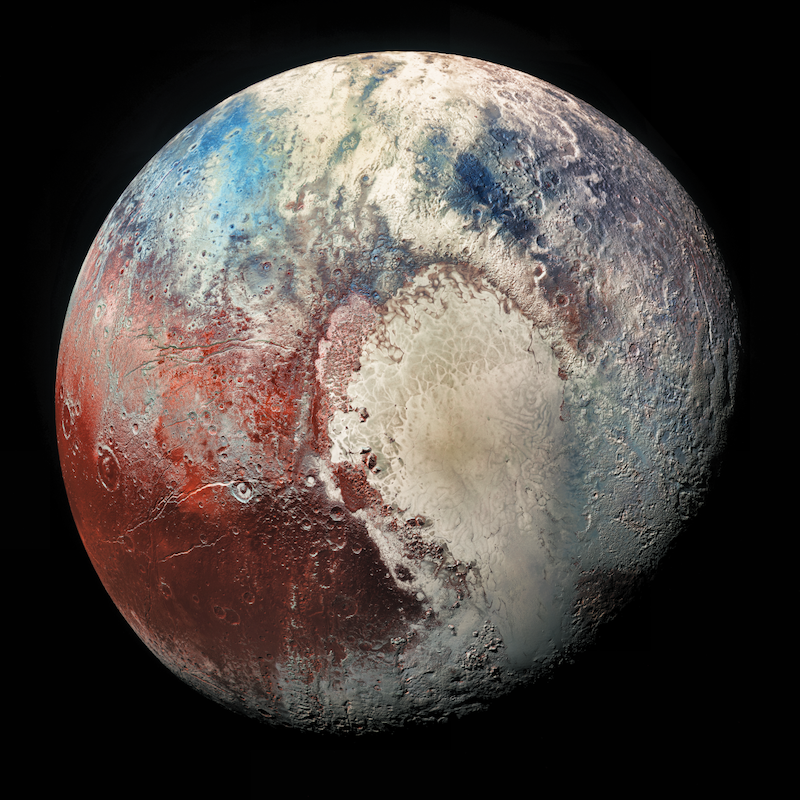
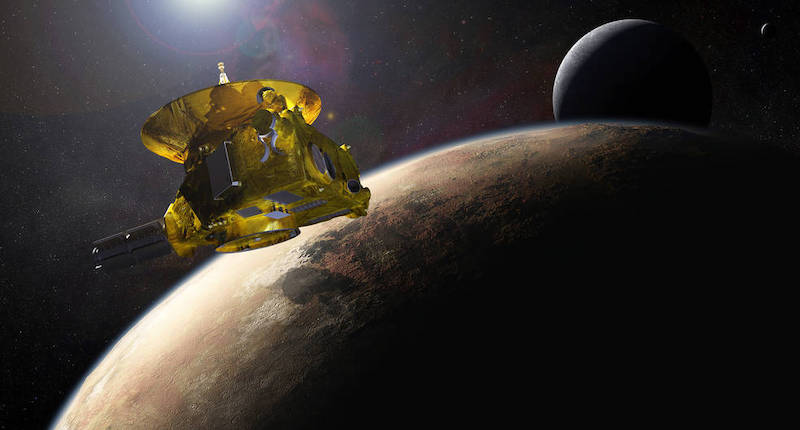
The marvels of Pluto
New Horizons revealed Pluto to be a much more active and dynamic world than previously thought possible. New Horizons Principal Investigator Alan Stern offered his thoughts, saying:
This newly published work is truly landmark, showing once again how much geologic personality Pluto for such a small planet has, and how it has been incredibly active over long periods. Even years after the flyby, these new results by Singer and coworkers show that there’s much more to learn about the marvels of Pluto than we imagined before it was explored up close.
With perhaps more heat inside Pluto than scientists expected, and maybe even an ocean, these findings also suggest the possibility of something even more exciting: life. Could there actually be microscopic life forms inside Pluto? That idea would have sounded almost unthinkable not too long ago. But now, who knows?
Bottom line: Unusual large icy domes on Pluto’s surface are likely giant ice volcanoes where water ice “lava” flowed, researchers say. They could explain some of the most enigmatic terrain on the dwarf planet’s surface. These ice volcanoes may even still be active today.
Source: Large-scale cryovolcanic resurfacing on Pluto
Via Johns Hopkins Applied Physics Laboratory
Via Southwest Research Institute
The post Pluto’s giant ice volcanoes may still be erupting first appeared on EarthSky.
0 Commentaires